|
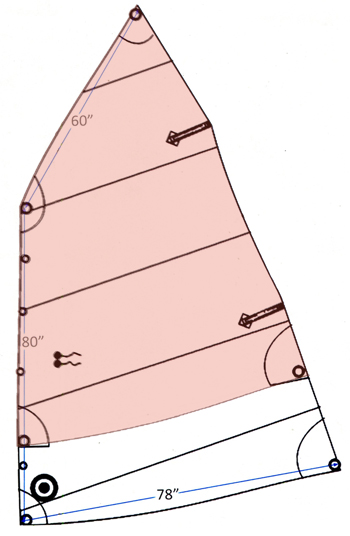
- Sail
and sail modifications:
I bought a nice Neil Pryde 45 sq. ft. tanbark sail from Duckworks. It was
the closest in size and shape to what I wanted. Actually, it was a little
too large for my intended use on this boat. The boat is pretty stable but
because of the cockpit design and depth it might not be easy or comfortable
to try to hike out in gusty conditions.
The sail had one set of reef points
and I cut and hemmed the sail there, between those points, keeping the
original foot shape . It now has an area of about 38 sq. ft. The shaded area
of the image is the sail's current size and shape. (Click image to see a
larger view)
Since this sail was intended to be set as a sprit sail and my preference is
for a balanced lug I needed to add 5 grommets along the top of the sail so
it could be laced to the yard.
I haven't added another set of reef points but probably will, depending
on how the boat reacts to stronger winds and gusts. This is a pretty small sail
and may not need to be reefed at all. Experience on the water will tell the
tale.
- Folding mast: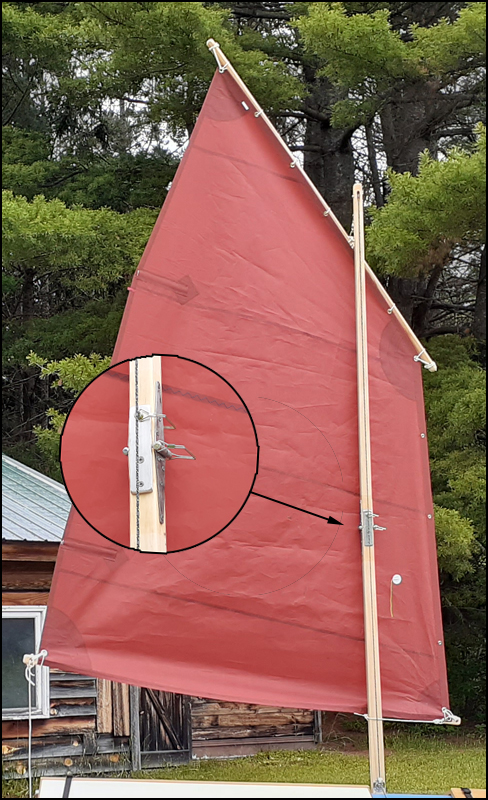
A major consideration was that the entire sail rig should fit inside
the cabin. There really isn't anyplace on deck to store a sail and spars
while rowing.
The boom and yard with the sail wrapped around them do just fit in there but
the mast needed to be 10' tall. I considered a couple of options; a folding
or telescoping mast. Since my preference was to make a wooden mast that
seemed to narrow it down to one that could fold in half.
After a little research I came up with this bit of hardware:
(Click image for larger view)
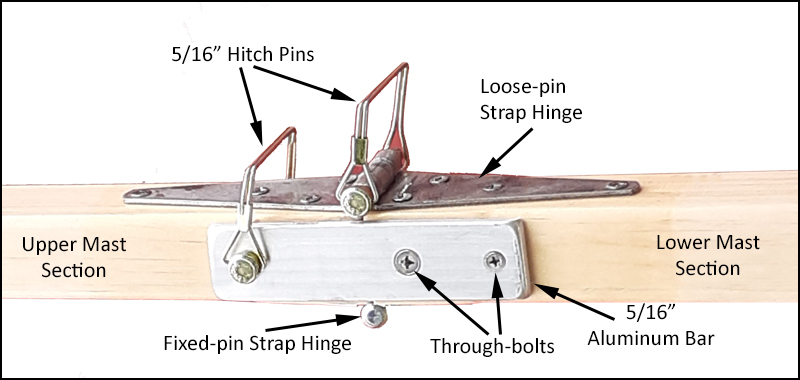
When folded the mast is 5'-2" long and stores nicely along the side of the
cabin sole.
And here is a short video of the
mast being setup
and another of
raising the sail.
In the videos the boat is sitting securely on the trailer and steady as a
rock. Raising the mast & sail on the water is a different thing. These
pointy ended boats are quite stable when the crew is in the central area but
as one moves toward the bow things get a little more tippy. With some
experience I'm sure it will work OK to raise and really more importantly,
lower the sail while afloat. My experience so far is that it is difficult to
keep the sail and spars out of the drink and once they are wet to keep that
water out of the cabin when raising the sail and later bringing it all
aboard.
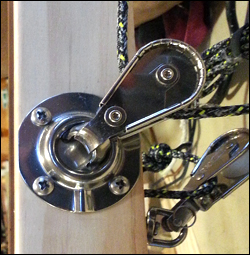 I mounted a 5/16" swivel base deck block to each side of the base of the
mast. The starboard block routes the halyard to the side of the boat where a
cheek block turns the line aft to a clamcleat on the cockpit gunwale. The
port deck block works I mounted a 5/16" swivel base deck block to each side of the base of the
mast. The starboard block routes the halyard to the side of the boat where a
cheek block turns the line aft to a clamcleat on the cockpit gunwale. The
port deck block works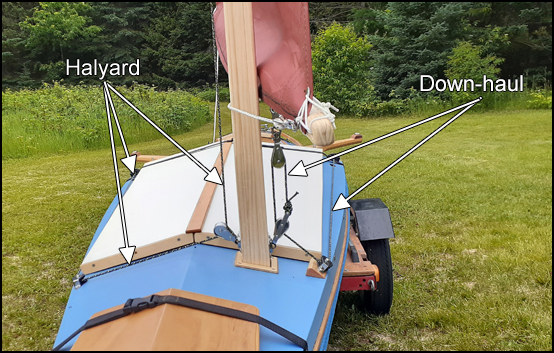 with a single becket block to create a 2:1 downhaul.
That line is routed along the port gunwale to the cockpit. with a single becket block to create a 2:1 downhaul.
That line is routed along the port gunwale to the cockpit.
Back to Top ]
- Spars - Boom & Yard:
The spars were made up by laminating two lengths of 5/4" Radiata pine
then shaping them both to reduce weight and to provide the right amount of
flexibility. The mast was tapered a little at the mast end then a long taper
to the other end. The yard was more drastically shaped with its thickest
area about a third of the way from the lower end. Both are 6' long and fit in
the cabin nicely bundled together with the sail loosely wrapped around them.
- Mast step and partner:
The step, where the base of the mast rests in the bottom of the boat,
is made up of several layers of marine plywood shaped to fit snuggly between
the port chine and the keel. It is firmly epoxied to both of those pieces
and to the bottom of the boat. It is in there for good! Below are couple of
photos of the step - first, straight down through the partner opening and
then as viewed from the cabin (with the mast kind of projected in place).
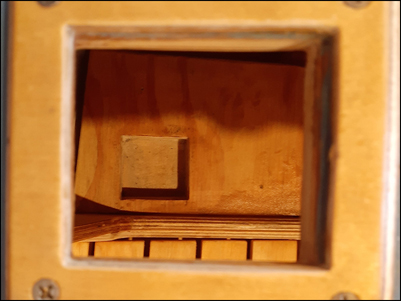

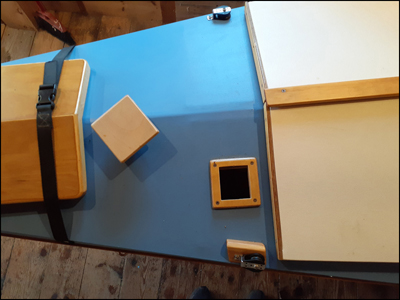
The partner is made from a couple of layers of plywood fitting tightly
between the inside of the gunwale and the center deck stringer and butting
up against the adjacent frame. It is fitted up under the deck fabric and the
opening is reinforced with a Baltic birch trim ring. That other thing on the
deck is a watertight plug fitted with a cam/toggle on the bottom, that seals
off the partner opening keeping the compartment below dry.
Mast location:
It became obvious when laying out the mast position that if I was to retain
the ability to lie down in the cabin the mast needed to be positioned as far
as possible to one side or the other. As you can see in the photos above,
the step is positioned as close to the port chine as I could and that
determined the partner location. Although most sailboats have their masts
centered many Phil Bolger boats nearly all of Jim Michalak's designs have
off-center masts and they reportedly sail just fine.
Having the mast positioned as it is there is still enough space to extend my
feet past it and be comfortable. Thinking ahead to overnighting aboard I'm
not sure if I would leave the mast up or not. I did notice that when rigging
the boat the bare mast seemed to help stabilize the boat which was nice. I
still, at this point have not figured out what the best way to handle the
sail/spar bundle at night - or any time when not sailing. A few in-the-shop
tests will help determine if there is a way to easily secure that 6 foot
long bundle along the edge of the cockpit and down the aft deck. It will
need to be far enough aft to not interfere with rowing.
[ Back to Top ]
- Sailing report:
I waited for the local waters to warm up a bit before heading out
with this totally untested experimental sailing rig. The day finally came
and we launched the boat at nearby Indian Lake. I stepped the mast while on
the trailer but left the spars & sail bundle on the floor of the
cabin. Sue held the boat to the launching dock while I got aboard to finish
the rigging. I had anticipated that standing at the forward end of the cabin
might be a bit tippy and indeed it was. I managed to get the spars in place
and halyard clipped to the yard OK but managing that slippery sailcloth
didn't go too well. The sail simply slithered out of my control into the
water. Not much to do but raise the sail and other than a little shower from
the gently flapping sail, all went well.
I moved back to the cockpit, adjusted the halyard, snugged up the downhaul
and sorted out the sheet and I was ready to go sailing. Sue let the boat
free and I was off on a port beam reach across the bay. I spent the next
hour or so experimenting with how much I needed to tip the leeward chine to
get the boat to windward. We had light gusty winds that made tacking a bit
of a challenge but eventually I did get out of the bay into a steadier
breeze and things kind of came together. Sue was paddling her kayak nearby
this whole time but I had the camera with me so no sailing photos yet.
My overall impression was that the boat was more stable than I had
anticipated. To the point that because the cockpit is so narrow it took
quite a bit of effort to get the chine to dig in - the boat just wants to
sit flat on top of the water. Normal draft by the way is less than 4". The
sailing was fun and I'm sure that setup will become smoother with a
little more experience with the rig.
The one change I made after that first trip was to add a 4" diam. x 1" PVC
ring at the halyard/spar attachment to keep the sail from kiting wildly
while raising the sail. It seems to work great on my shore tests. More
reports will follow after a few more sailing adventures.
[ Back to Top ]
- Late Fall Follow-up -
November, 2022:
As I mentioned at the top of this page, my intent when designing and
building this boat was that it would be a great rowboat. I also intended to
row it every chance I got and that's pretty much the way the summer of 2022
went. It is so easy to just hook up the trailer, drive a few miles to nearby
inland lakes or to Lake Michigan, launch and go rowing that the sail
rig stayed home. The boat is in the shop for the winter now for some minor
maintenance but just writing this makes me want to go sailing.
I'm almost tempted to build a nice little 'real' sailboat but don't feel as
though I've given this one much of a chance, so I'm semi-committed to sticking
with this one for at least another summer. Besides, I have run out of places
to store boats... It's hard because Sue is so supportive. If I said "I think
I'd like to build another boat", she'd say "Go for it if it will make you
happy". Life here on the homestead is good!
|

